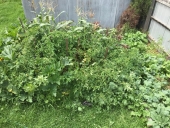
 6
6




SKIP books, get 'em while they're hot!!! Skills to Inherit Property

 1
1




List of Bryant RedHawk's Epic Soil Series Threads We love visitors, that's why we live in a secluded cabin deep in the woods. "Buzzard's Roost (Asnikiye Heca) Farm." Promoting permaculture to save our planet.




 If I try it again I'll do more broadforking to see if that fixes the issue. I'd think ideally in the fall and spring prior to planting.
If I try it again I'll do more broadforking to see if that fixes the issue. I'd think ideally in the fall and spring prior to planting.SKIP books, get 'em while they're hot!!! Skills to Inherit Property

 1
1




"Never doubt that a small group of thoughtful, committed citizens can change the world; indeed, it's the only thing that ever has."-Margaret Mead "The only thing worse than being blind, is having sight but no vision."-Helen Keller





SKIP books, get 'em while they're hot!!! Skills to Inherit Property




 1
1




![Filename: DSC04573s.jpg
Description: [Thumbnail for DSC04573s.jpg]](/t/88559/a/63532/DSC04573s.jpg)
![Filename: DSC04574s.jpg
Description: [Thumbnail for DSC04574s.jpg]](/t/88559/a/63533/DSC04574s.jpg)
SKIP books, get 'em while they're hot!!! Skills to Inherit Property



